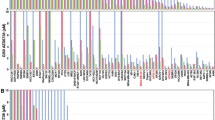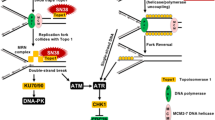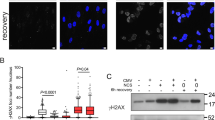Abstract
The herpes simplex virus thymidine kinase (HSV-TK) is the most widely used suicide gene in cancer gene therapy due to its superior anticancer activity with ganciclovir (GCV) compared with other HSV-TK substrates, such as 1-β-D-arabinofuranosyl thymine (araT). We have evaluated the role of DNA damage as a mechanism for the superiority of GCV. Using γ-H2AX foci as an indicator of DNA damage, GCV induced ⩾sevenfold more foci than araT at similar cytotoxic concentrations. The number of foci decreased after removal of either drug, followed by an increase in Rad51 foci indicating that homologous recombination repair (HRR) was used to repair this damage. Notably, only GCV produced a late and persistent increase in γ-H2AX foci demonstrating the induction of unrepairable DNA damage. Both drugs induced the ATR damage response pathway, as evidenced by Chk1 activation. However, GCV resulted in greater activation of ATM, which coincided with the late induction of γ-H2AX foci, demonstrating the presence of DNA double-strand breaks (DSBs). The increase in DSBs after Rad51 induction suggested that they occurred as a result of a failed attempt at HRR. These data demonstrate that the late and unrepairable DSBs observed uniquely with GCV account for its superior cytotoxicity and further suggest that inhibition of HRR will enhance cytotoxicity with HSV-TK/GCV.
This is a preview of subscription content, access via your institution
Access options
Subscribe to this journal
Receive 12 print issues and online access
$259.00 per year
only $21.58 per issue
Buy this article
- Purchase on Springer Link
- Instant access to full article PDF
Prices may be subject to local taxes which are calculated during checkout






Similar content being viewed by others
Abbreviations
- araT:
-
1-β-D-arabinofuranosyl thymine
- BrdUrd:
-
5-bromo-2′-deoxyuridine
- DSB:
-
double-strand break
- GCV:
-
ganciclovir
- GCVMP:
-
ganciclovir monophosphate
- HRR:
-
homologous recombination repair
- HSV-TK:
-
herpes simplex virus thymidine kinase
References
Moolten FL . Drug sensitivity (‘suicide’) genes for selective cancer chemotherapy. Cancer Gene Ther 1994; 1: 279–287.
Roth JA, Cristiano RJ . Gene therapy for cancer: what have we done and where are we going? J Natl Cancer Inst 1997; 89: 21–39.
Freytag SO, Khil M, Stricker H, Peabody J, Menon M, DePeralta-Venturina M et al. Phase I study of replication-competent adenovirus-mediated double suicide gene therapy for the treatment of locally recurrent prostate cancer. Cancer Res 2002; 62: 4968–4976.
Freytag SO, Stricker H, Pegg J, Paielli D, Pradhan DG, Peabody J et al. Phase I study of replication-competent adenovirus-mediated double-suicide gene therapy in combination with conventional-dose three-dimensional conformal radiation therapy for the treatment of newly diagnosed, intermediate- to high-risk prostate cancer. Cancer Res 2003; 63: 7497–7506.
Rubsam LZ, Davidson BL, Shewach DS . Superior cytotoxicity with ganciclovir compared with acyclovir and 1-{beta}-D-arabinofuranosylthymine in herpes simplex virus-thymidine kinase-expressing cells: a novel paradigm for cell killing. Cancer Res 1998; 58: 3873–3882.
Cheng YC, Grill SP, Dutschman GE, Nakayama K, Bastow KF . Metabolism of 9-(1,3-dihydroxy-2-propoxymethyl)guanine, a new anti-herpes virus compound, in herpes simplex virus-infected cells. J Biol Chem 1983; 258: 12460–12464.
Halloran PJ, Fenton RG . Irreversible G2-M arrest and cytoskeletal reorganization induced by cytotoxic nucleoside analogues. Cancer Res 1998; 58: 3855–3865.
Tomicic MT, Thust R, Kaina B . Ganciclovir-induced apoptosis in HSV-1 thymidine kinase expressing cells: critical role of DNA breaks, Bcl-2 decline and caspase-9 activation. Oncogene 2002; 21: 2141–2153.
Thust R, Tomicic M, Klocking R, Voutilainen N, Wutzler P, Kaina B . Comparison of the genotoxic and apoptosis-inducing properties of ganciclovir and penciclovir in Chinese hamster ovary cells transfected with the thymidine kinase gene of herpes simplex virus-1: implications for gene therapeutic approaches. Cancer Gene Ther 2000; 7: 107–117.
Thust R, Tomicic M, Klocking R, Wutzler P, Kaina B . Cytogenetic genotoxicity of anti-herpes purine nucleoside analogues in CHO cells expressing the thymidine kinase gene of herpes simplex virus type 1: comparison of ganciclovir, penciclovir and aciclovir. Mutagenesis 2000; 15: 177–184.
Sonoda E, Sasaki MS, Morrison C, Yamaguchi-Iwai Y, Takata M, Takeda S . Sister chromatid exchanges are mediated by homologous recombination in vertebrate cells. Mol Cell Biol 1999; 19: 5166–5169.
O’Konek JJ, Boucher PD, Iacco AA, Wilson TE, Shewach DS . MLH1 deficiency enhances tumor cell sensitivity to ganciclovir. Cancer Gene Ther 2009; 16: 683–692.
Rogakou EP, Pilch DR, Orr AH, Ivanova VS, Bonner WM . DNA double-stranded breaks induce histone H2AX phosphorylation on serine 139. J Biol Chem 1998; 273: 5858–5868.
Sedelnikova OA, Rogakou EP, Panyutin IG, Bonner WM . Quantitative detection of (125)IdU-induced DNA double-strand breaks with gamma-H2AX antibody. Radiat Res 2002; 158: 486–492.
Rogakou EP, Boon C, Redon C, Bonner WM . Megabase chromatin domains involved in DNA double-strand breaks in vivo. J Cell Biol 1999; 146: 905–916.
Paull TT, Rogakou EP, Yamazaki V, Kirchgessner CU, Gellert M, Bonner WM . A critical role for histone H2AX in recruitment of repair factors to nuclear foci after DNA damage. Curr Biol 2000; 10: 886–895.
Robinson BW, Ostruszka L, Im MM, Shewach DS . Promising combination therapies with gemcitabine. Semin Oncol 2004; 31: 2–12.
O’Konek JJ, Ladd B, Flanagan SA, Im MM, Boucher PD, Thepsourinthone TS et al. Alteration of the carbohydrate for deoxyguanosine analogs markedly changes DNA replication fidelity, cell cycle progression and cytotoxicity. Mutation Res 2010; 684: 1–10.
Rothkamm K, Kruger I, Thompson LH, Lobrich M . Pathways of DNA double-strand break repair during the mammalian cell cycle. Mol Cell Biol 2003; 23: 5706–5715.
Saleh-Gohari N, Helleday T . Conservative homologous recombination preferentially repairs DNA double-strand breaks in the S phase of the cell cycle in human cells. Nucleic Acids Res 2004; 32: 3683–3688.
Wyman C, Ristic D, Kanaar R . Homologous recombination-mediated double-strand break repair. DNA Repair (Amst) 2004; 3: 827–833.
Plunkett W, Chubb S, Alexander L, Montgomery JA . Comparison of the toxicity and metabolism of 9-beta-D-arabinofuranosyl-2-fluoroadenine and 9-beta-D-arabinofuranosyladenine in human lymphoblastoid cells. Cancer Res 1980; 40: 2349–2355.
Graham FL, Whitmore GF . Studies in mouse L-cells on the incorporation of 1-beta-D-arabinofuranosylcytosine into DNA and on inhibition of DNA polymerase by 1-beta-D-arabinofuranosylcytosine 5′-triphosphate. Cancer Res 1970; 30: 2636–2644.
Parker WB, Shaddix SC, Chang CH, White EL, Rose LM, Brockman RW et al. Effects of 2-chloro-9-(2-deoxy-2-fluoro-beta-D-arabinofuranosyl)adenine on K562 cellular metabolism and the inhibition of human ribonucleotide reductase and DNA polymerases by its 5′-triphosphate. Cancer Res 1991; 51: 2386–2394.
Rothkamm K, Lobrich M . Evidence for a lack of DNA double-strand break repair in human cells exposed to very low X-ray doses. Proc Natl Acad Sci USA 2003; 100: 5057–5062.
Liu JS, Kuo SR, Melendy T . Comparison of checkpoint responses triggered by DNA polymerase inhibition versus DNA damaging agents. Mutat Res 2003; 532: 215–226.
Ha L, Ceryak S, Patierno SR . Generation of S phase-dependent DNA double-strand breaks by Cr(VI) exposure: involvement of ATM in Cr(VI) induction of gamma-H2AX. Carcinogenesis 2004; 25: 2265–2274.
Abate-Daga D, Garcia-Rodrøguez L, Sumoy L, Fillat C . Cell cycle control pathways act as conditioning factors for TK/GCV sensitivity in pancreatic cancer cells. Biochimica et Biophysica Acta 2010; 1803: 1175–1185.
Tomicic MT, Bey E, Wutzler P, Thust R, Kaina B . Comparative analysis of DNA breakage, chromosomal aberrations and apoptosis induced by the anti-herpes purine nucleoside analogues aciclovir, ganciclovir and penciclovir. Mutat Res 2002; 505: 1–11.
Acknowledgements
This work was supported in part by grants CA076581 and CA083081 from the NIH. The project described was supported by grant number GM007767 from NIGMS. Its contents are solely the responsibility of the authors and do not necessarily represent the official views of NIGMS. The immunohistochemistry work was performed in the Microscopy and Image-analysis Laboratory (MIL) at the University of Michigan, Department of Cell & Developmental Biology with the assistance of Shelley Almburg.
Author information
Authors and Affiliations
Corresponding author
Ethics declarations
Competing interests
The authors declare no conflict of interest.
Rights and permissions
About this article
Cite this article
Ladd, B., O'Konek, J., Ostruszka, L. et al. Unrepairable DNA double-strand breaks initiate cytotoxicity with HSV-TK/ganciclovir. Cancer Gene Ther 18, 751–759 (2011). https://doi.org/10.1038/cgt.2011.51
Received:
Revised:
Accepted:
Published:
Issue Date:
DOI: https://doi.org/10.1038/cgt.2011.51
Keywords
This article is cited by
-
Harnessing Rift Valley fever virus NSs gene for cancer gene therapy
Cancer Gene Therapy (2022)
-
A human Myogenin promoter modified to be highly active in alveolar rhabdomyosarcoma drives an effective suicide gene therapy
Cancer Gene Therapy (2021)
-
Interleukin33 deficiency causes tau abnormality and neurodegeneration with Alzheimer-like symptoms in aged mice
Translational Psychiatry (2017)



